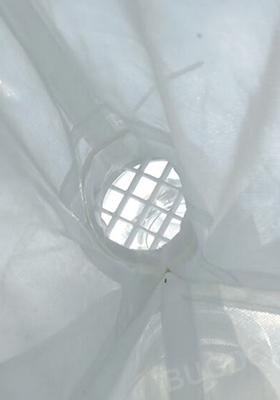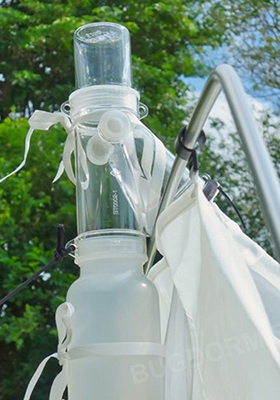Dual-headed design for insect flight-direction studies
The ez-Migration trap—a dual-headed Malaise trap—enables passive, unbaited sampling with direction-resolved catches. Insects intercepted on both sides enter separate collection bottles. Shock-corded poles and clip-on fittings allow rapid, stand-alone setup for migration and short-range dispersal studies. The design is patented.
Field Application: Recent work used the BugDorm ez-Migration trap bidirectionally: a Pyrenean pass (Roncesvalles; southwest–northeast) quantifying nightly flows (Proc. R. Soc. B 2024); and a 2018–2021 autumn program with direction-resolved sex ratio/morphometrics (Open Biology 2025).
Detailed Description
Classical Malaise traps often exhibit directional asymmetry, with collection heads filling unevenly depending on sun position, wind direction, or insect flight paths. By placing a head at each end, the ez-Migration trap keeps catches from opposing directions separate, making orientation effects explicit so they can be quantified and compared within the same deployment.
Assembly mirrors that of the ez-Malaise trap: shock-corded poles connect in minutes, clips attach the fabric body, and stability in open landscapes requires a minimum of two guy ropes (add more in windy conditions). Components such as the collection head, fabric body, and shock-corded poles can be replaced individually, reducing downtime and extending service life.
Each inverted Y-shaped collection head is molded from solid polycarbonate for durability, UV resistance, and high transparency. Ventilation ports, closed by default, allow optional airflow, and some field reports note increased catch efficiency with enhanced airflow. A removable moth excluder with 1 × 1 cm grid spacing discourages larger insects (e.g., Lepidoptera) and helps reduce wing-scale contamination. Seat each head on the supporting pole rather than the fabric body to maintain alignment.
Removable Moth Excluder
 Removable Moth Excluder
Removable Moth Excluder
Collection Head Placement
 Collection Head Placement
Collection Head Placement
Functional Advantages
- Bidirectional sampling: Dual heads keep opposing-direction catches separate for within-deployment comparisons and clearer movement signals.
- Rapid setup: Shock-corded poles and clip-on assembly enable quick deployment without external supports.
- Modular system: Interchangeable heads, fabric body, and poles reduce downtime and extend service life.
- Collection heads: Durable polycarbonate with optional airflow vents and removable moth excluders to reduce contamination.
- Portable structure: Nearly freestanding; requires at least two guy ropes for stability.
Authenticity: The ez-Migration trap is an original, field-proven design cited in many peer-reviewed studies. Copies may exist, but only the BugDorm ez-Migration Trap adheres to strict material, mesh, and dimensional specifications, ensuring repeatable results and cross-site comparability.
Field Notes
- Placement: Position across trails, forest edges, and riparian strips; set the central barrier roughly perpendicular to expected insect flight paths and avoid tight vegetation that blocks airflow.
- Collection heads: Seat each head on the end supporting pole, not the fabric. Keep both intakes upright and unobstructed, tie securely, and recheck seating after line re-tensioning or whenever a collection bottle is serviced.
- Ventilation ports: Open ports of the collection head can improve airflow but may also admit rainwater, causing preservative dilution. They can likewise accelerate evaporation.
- Directional metadata: Label the two heads consistently (e.g., A/B or compass bearings) and record trap orientation at setup to support directional comparisons.
- Preservative and labels: Use ethanol or propylene glycol as appropriate. Label each bottle with trap ID, head ID, date/time, preservative, and orientation notes.
- Sun and wind: Note sun position and wind direction at deployment and each servicing to aid interpretation of directional differences.
- Servicing: Empty or replace bottles on a regular schedule (e.g., weekly), adjusting for catch volume and temperature. Re-tension guy ropes after strong winds or a heavy catch to maintain panel shape.
- Study design: For multiple traps, space units 50–150 m apart to reduce spatial dependence; log trap-days and covariates (weather, vegetation structure, edge distance). For short-term surveys, reposition along movement axes or across habitat edges and record coordinates and orientations at each move.
Field Checklist
Before You Leave the Site
- Select site with open airflow; avoid dense vegetation blocking either head.
- Orient central panel perpendicular to expected movement; record compass bearing; label heads A/B.
- Assemble shock-corded poles; secure a minimum of two guy ropes (add more in wind).
- Seat both collection heads on the supporting poles; verify intakes upright and unobstructed.
- Install moth excluders if needed (1 × 1 cm grid) to reduce large-insect entry.
- Fill bottles with chosen preservative to equal levels; apply labels with trap ID, head ID, date/time, and orientation.
- Decide on ventilation-port status; note open/closed in field log (consider rain and evaporation risk).
- Service schedule set (e.g., weekly); replace/empty bottles; re-tension lines after wind or heavy catches.
- At deployment and each servicing, note sun position and wind direction.
- For arrays, space traps 50–150 m; record GPS, orientation, and site covariates.
ℹ︎ Disclaimer: Field Notes & Checklist provide practical guidance and examples. Actual procedures should be adapted to site conditions, study objectives, and institutional protocols. Users are responsible for safe deployment and compliance with local regulations.
Pack Contents
- 1 × Fabric Trap Body
- 2 × Shock-corded Poles (L459 cm)
- 2 × Collection Heads (pre-installed)
- 6 × Collection Bottles (2 pre-installed)
alternative option
Nalgene™ 2105-0016 wide-mouth bottles (53 mm closure size; unavailable from this site) are compatible with the supplied bottles.
- 10 × Guy Ropes
- 10 × Plastic X-Stakes
- 8 × Alloy Pin Stakes
- 1 × Carrying Bag
Prepare extra guy ropes and stakes as needed. Additional replacement parts are listed under the Parts tab.
Recent Literature Related to This Product Line (click to search more)
- The Hemiptera (Insecta) of Canada: Constructing a Reference Library of DNA Barcodes. Gwiazdowski et al. (2015). PLoS One, 10(4), e0125635.
- DNA barcoding in diverse educational settings: five case studies. Henter et al. (2016). Phil. Trans. R. Soc. B, 371(1702), 20150340.
- The School Malaise Trap Program: coupling educational outreach with scientific discovery. Steinke et al. (2017). PLoS Biology, 15(4), e2001829.
- Arthropods in modern resins reveal if amber accurately recorded forest arthropod communities. Solórzano Kraemer et al. (2018). PNAS, 115(26), 6739–6744.
- Expedited assessment of terrestrial arthropod diversity by coupling Malaise traps with DNA barcoding. deWaard et al. (2019). Genome, 62(3), 85–95.
- Using DNA-barcoded Malaise trap samples to measure impact of a geothermal energy project on the biodiversity of a Costa Rican old-growth rain forest. Janzen et al. (2020). Genome, 63(9), 407–436.
- A Review of Terrestrial and Canopy Malaise Traps. Michael et al. (2021). Ann. Entomol. Soc. Am., 114(1), 27–47.
- Peering into the Darkness: DNA Barcoding Reveals Surprisingly High Diversity of Unknown Species of Diptera (Insecta) in Germany. Chimeno et al. (2022). Insects, 13(1), 82.
- Optimizing insect metabarcoding using replicated mock communities. Iwaszkiewicz-Eggebrecht et al. (2023). Methods in Ecology and Evolution, 14(4), 1130–1146.
- Global arthropod beta-diversity is spatially and temporally structured by latitude. Seymour et al. (2024). Communications Biology, 7(1), 552.